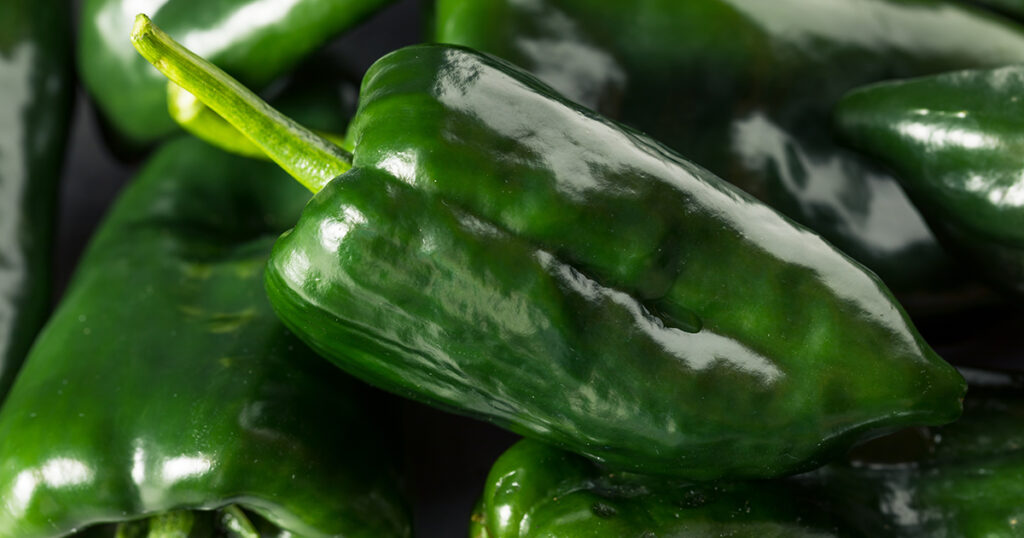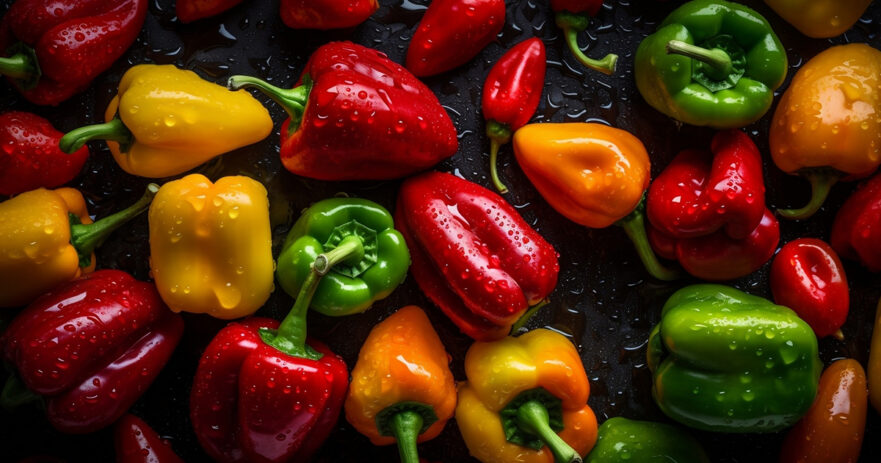Versatile peppers are culinary treasures, ranging from mild to fiery. Whether in salads, grilled, or blended into sauces, they add delightful flavor and heat, making them essential for elevating dishes.
Peppers, those vibrant and flavorful fruits, have long been cherished in the culinary world for their versatility and ability to transform ordinary dishes into extraordinary creations. From the mild and sweet bell peppers to the fiery habaneros and everything in between, the world of pepper varieties offers a rich tapestry of tastes, colors, and heat levels.
Whether you want to add a subtle kick to a salad, infuse a sauce with depth, or create a sizzling stir-fry, the diverse array of pepper varieties is ready to take your culinary adventures to new heights. Join us as we delve into the captivating realm of versatile pepper varieties and discover their endless gastronomy possibilities.
Key Takeaways
- Jalapeño peppers are spicy, low-calorie, and packed with nutrients. [1]
- Poblano peppers are mild to hot, rich in vitamins, and a staple in Mexican cuisine. [2]
- Serrano peppers are small, hot, and highly nutritious, providing vitamin C, B6, fiber, and potassium. [3] [18]
- Shishito peppers are popular, sweet, non-pungent fruits. [4]
- Anaheim peppers are mild to hot and longer than jalapeños, with colorful variations. [5]
Bell Peppers
Bell peppers, also known as sweet peppers, are like colorful Christmas ornaments in the vegetable world. They come in a stunning array of vivid colors, from green and red to yellow, orange, purple, brown, and black. When biting a bell pepper, you’ll enjoy a delightful, slightly watery crunch. The green and purple varieties have a subtle bitterness, while the red, orange, and yellow ones are sweeter and almost fruity. Pimento and paprika are both prepared from red bell peppers [6]. These veggies are packed with essential nutrients like vitamins B, A, C, E, and K and minerals like potassium, sodium, magnesium, calcium, and phosphorus, making them a healthy addition to your meals [7]. Bell peppers can be used in various dishes, from salads, stir-fries, and fajitas to stuffed peppers, roasted sides, and flavorful sauces.
Jalapeño Peppers
Jalapeños are spicy chili peppers, small in size, and come in green or red colors. They are widely used in Mexican cuisine and are loved worldwide. Besides adding a kick to your dishes, jalapeños also offer great health benefits. They are rich in vitamins, minerals, fiber, and antioxidants, making them a nutritious choice. With low-calorie content, jalapeños are great for those watching their weight. They provide a good dose of vitamin C, essential for healthy skin, and vitamin B6, crucial for various bodily functions. Additionally, jalapeños may even support weight loss by boosting metabolism, aiding fat burn, and reducing appetite [1]. Jalapeño peppers are often used to add spiciness and flavor to salsas, guacamole, and other dips, enhancing the overall taste of the dishes.
Poblano Peppers

Poblano and Ancho peppers fall between mild and hot on the spiciness scale. When green, they are called Poblano; when dried, they are known as Ancho [5]. Poblano pepper, scientifically named Capsicum annuum, holds immense economic significance in Mexico due to its widespread cultivation and consumption. These peppers are packed with vitamins (A, E, B, and C), folic acid, and potassium, offering therapeutic benefits for human health. No wonder they play a crucial role in Mexican cuisine as a basic and flavorful ingredient [2]. Poblano peppers are perfect for making traditional Mexican dishes like chiles rellenos or adding a subtle kick to soups, stews, and sauces.
Cayenne Peppers
Due to its potential medicinal properties, Cayenne pepper is widely utilized as a natural remedy for alleviating acute or chronic back pain and rheumatism [17]. Cayenne pepper is rich in antioxidants, such as vitamin C, vitamin E, beta carotene, choline, lutein, zeaxanthin, and cryptoxanthin, which gives the pepper its red color [8]. Antioxidants are beneficial for health as they help the body eliminate harmful free radicals, which can cause various health issues like heart disease and neurodegenerative conditions like Alzheimer’s [12]. Cayenne peppers often add a bold and spicy kick to various cuisines, including hot sauces, marinades, and chili recipes.
Serrano Peppers
Serrano peppers are small but pack a punch with their spiciness [5]. These peppers start green and change to red or yellow as they mature [3]. Besides the heat, they also offer valuable nutrition. Just one cup of chopped serrano pepper provides approximately 50-60 percent of the daily recommended vitamin C, 30 – 40 percent of vitamin B6, 12-15 percent of fiber, 9 percent of potassium, and 15 percent of copper [18]. Serrano peppers are popular for adding a spicy punch to salsas, pico de gallo, and other zesty Mexican dishes.
Habanero Peppers
Habaneros (Capsicum chinense) are incredibly spicy peppers, small in size, and shaped like lanterns [5]. These peppers are famous for being one of the world’s hottest chili peppers and are highly aromatic, making their aroma one of their most alluring qualities. In Mexico, the Yucatan region is a significant producer of C. chinense Jacq, known as Yucatan Habanero pepper [9]. Habaneros come in various forms: typical ones turn orange when ripe, while others mature to red, brown, white, or even purple [10]. Besides their use in hot sauces and spicy marinades, habanero peppers can infuse oils and vinegar, adding a delightful kick to dressings and vinaigrettes.
Anaheim Peppers
Anaheim peppers, also called New Mexican Chile, are longer than jalapeños and have a mild to hot spiciness. When fresh, they come in bright green to red colors; in their dried form, they turn brownish red [5]. These versatile peppers add flavor and spice to various dishes, making them a popular choice in cuisines. They are excellent for roasting, grilling, or stuffing, adding a delightful taste to dishes like chiles rellenos, enchiladas, and salsas.
Shishito Peppers
Shishito peppers are popular, small, green, and non-spicy. There are different derived varieties from Shishito, including “Shishi-homare” (a favorite in Japan), “105c-10” (low-spicy mutation line from “Shishi-homare”), “Kounou Shishito,” and “Kairyo Shishito.” Among them, “Kounou Shishito” has the smallest fruit shape. These sweet and mild peppers are favored for their delicious taste in Japanese cuisine [4]. These peppers are often pan-fried or grilled whole until blistered, making them a delicious and addictive appetizer. Their versatility extends to being used in stir-fries, tempura, and as a tasty topping for pizzas and sandwiches.
Cubanelle Peppers
Italian or Cubanelle peppers are known for their sweet to mildly hot taste and have a long, somewhat flattened shape. These flavorful peppers undergo a delightful transformation as they ripen, changing from yellow-green to orange and turning red [5]. They also add a delightful crunch and flavor to salads, sandwiches, and antipasto platters, making them versatile in various culinary creations.
Banana Peppers
Banana peppers have long fruits that start pale yellow-green and turn yellow, eventually maturing to bright red. They come in hot and mild (sweet) varieties, with some hot ones known as Hungarian Wax [5]. Despite being low in calories, banana peppers are filling due to their high fiber content. They are a nutritional powerhouse, rich in essential vitamins and minerals. For instance, a one-cup serving provides 103 milligrams of vitamin C and 422IU of Vitamin A, which are known antioxidants and play an essential role in the normal functioning of the immune system, nerves, wound healing, and eye health, among others [11] [13] [16]. Additionally, banana peppers are versatile enough to be pickled or stuffed with cheese, meats, or grains, creating delicious appetizers or side dishes.
Uba Tuba
Uba Tuba, also known as Capsicum baccatum, is a mild pepper with a unique taste. The pepper’s fruit has a novel flower-like shape and starts as green, gradually turning to a beautiful ruby red when ripe. Once fully ripe, the fruit becomes sweet and delightful [5]. Uba Tuba peppers are perfect for adding a distinctive touch to salads, salsas, and marinades, enhancing the overall taste of your dishes with their unique profile.
Summary
As we reach the end of our flavorful exploration, the diverse and versatile world of pepper varieties leaves us in awe. Each pepper possesses its captivating personality, teasing our taste buds in delightful ways. The vast array of colors, sizes, and flavors presents an enticing playground for aspiring home cooks and professionals. From the robust Poblano to the playful Shishito, these peppers have become a culinary muse, inspiring the chef to experiment and create complex and charming dishes. So, brace yourself to infuse your dishes with their magic, taking your culinary endeavors to new heights and creating a symphony of delightful flavors that’ll leave everyone craving more.
FAQ
What is the most versatile pepper?
The bell pepper (Capsicum annum L.) is considered the most versatile due to its high nutritional value, a wide range of bioactive compounds, and endless use possibilities. These compounds, including phenols, flavonoids, carotenoids, tocopherol, and pectic polysaccharides, offer numerous health benefits. The constituents in bell peppers exhibit antioxidant, antibacterial, and antifungal properties, as well as immunosuppressive and immunostimulant properties. Additionally, they have antidiabetic, antitumoral, and neuroprotective activities. Bell peppers can be used in various culinary applications to enhance flavor and health benefits [7].
What are the multi-colored peppers called?
The multi-colored peppers are called bell peppers. Depending on their ripening stages and capacity to synthesize chlorophylls or carotenoids, they can come in various colors, such as red, green, orange, and yellow [7].
What is the best pepper in the world?
Determining the "best" pepper is subjective, as it depends on personal preferences. The Shishito pepper is favored for its sweet, mild taste in Japanese cuisine. The Habanero pepper's extreme heat and aroma may be appealing if you prefer spiciness. Taste varies, with some favoring the sweetness of Cubanelle peppers or the versatility of bell peppers. The Anaheim pepper offers a mild to hot spiciness. Ultimately, the best pepper depends on the individual taste and the prepared dish. Exploring different pepper varieties will help discover the one that suits personal preferences and culinary needs.
What is the most expensive pepper?
The Aji Charapita chili pepper is the most expensive in the world. Native to the jungles of northern Peru, it is roughly the size of a pea but comes with a hefty price tag. A kilogram of Aji Charapita pepper costs an astonishing $35,000. Despite its small size, this wild pepper packs a solid fruity flavor, lending a tropical taste to salsas and sauces. It is commonly used in powdered form to add a touch of spiciness to various dishes [14].
What pepper do chefs use?
Chefs often use bell peppers in their dishes due to their versatility, crunch, distinct flavor, and vibrant colors. Bell peppers can be grilled, cooked, or stir-fried, making them suitable for various culinary applications. They can be enjoyed on their own, used as a side dish, or even take center stage as the hero ingredient in a dish [15].

